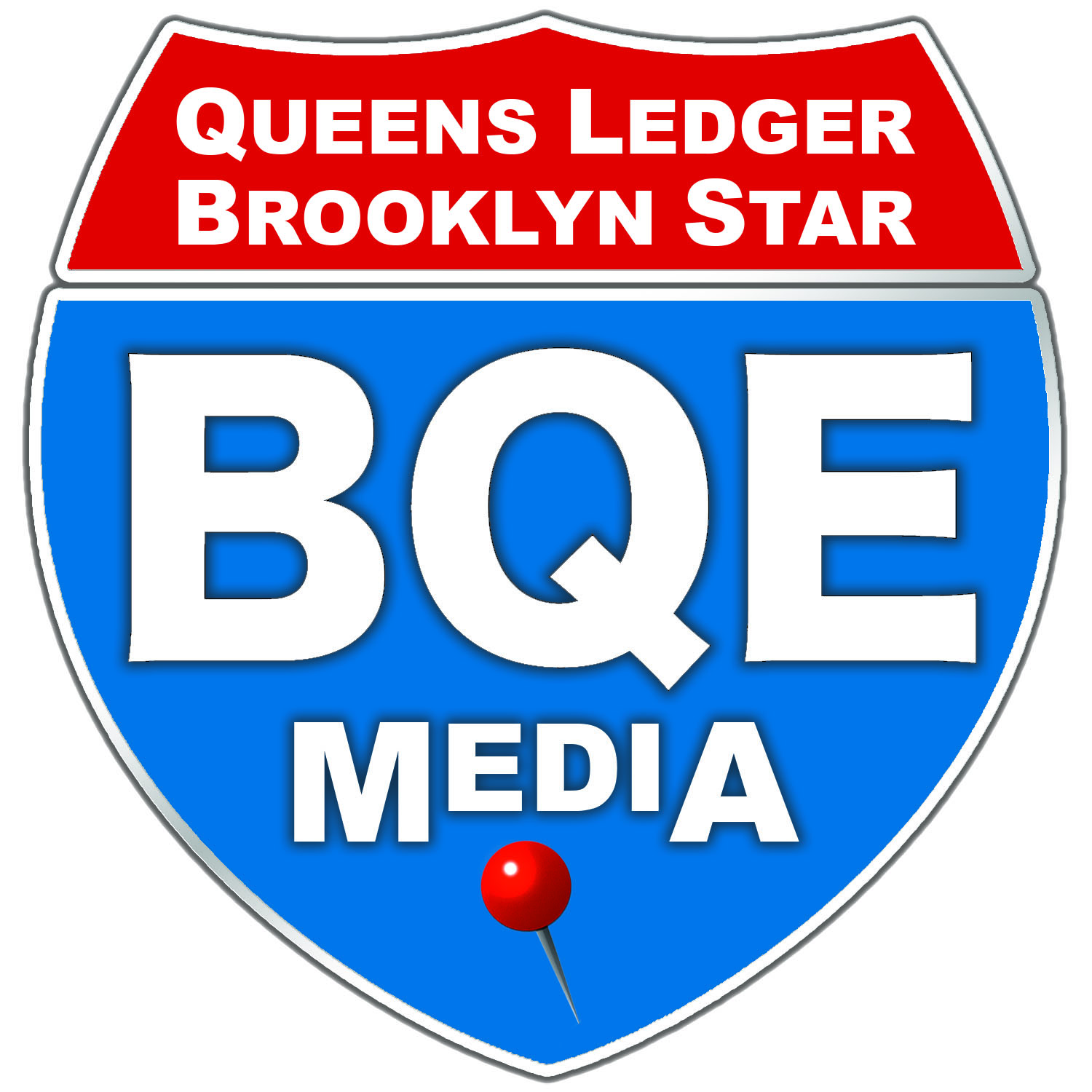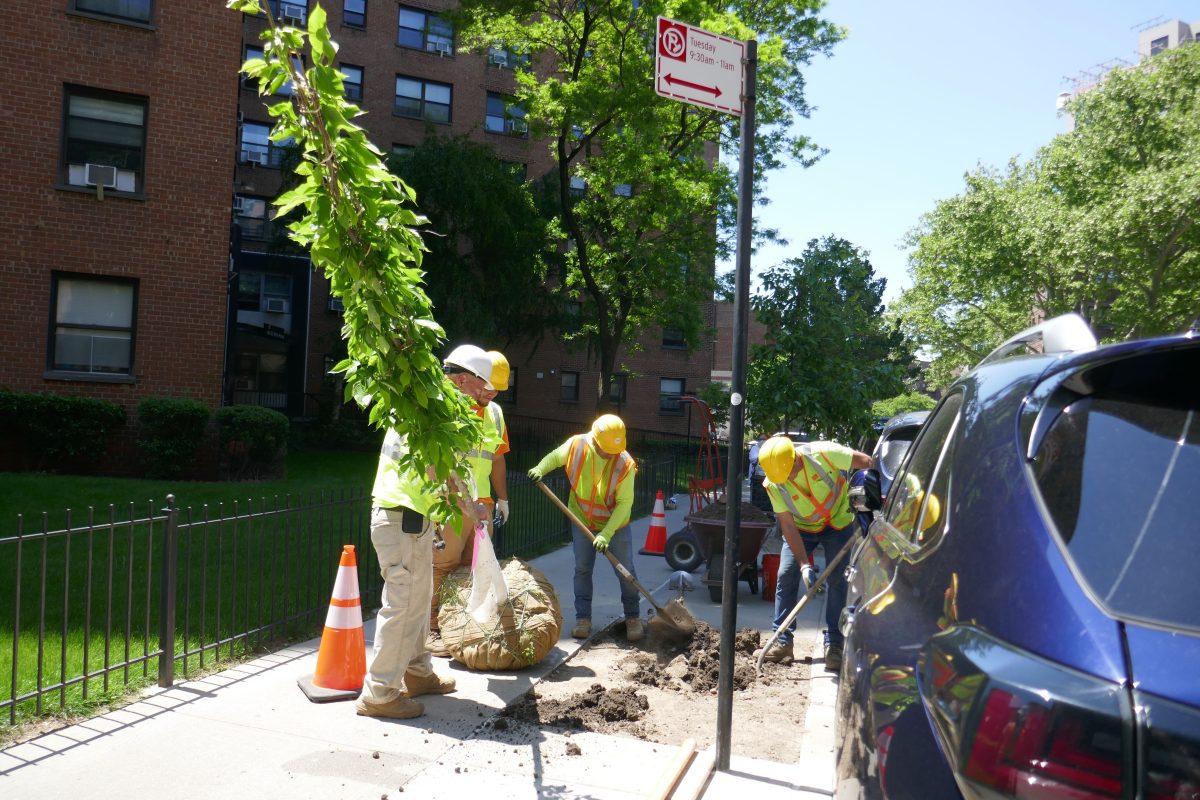By Michael Perlman
Throughout 2025, residents and city staffers will continue to restore the “forest” in Forest Hills, the “park” in Rego Park, and communities throughout the five boroughs by expanding and diversifying the tree canopy. The Parks Department and the New York Restoration Project (NYRP) nonprofit are among the organizations in full swing. Earth Day is on April 22, followed by National Love A Tree Day on May 16.
A number of opportunities exist for residents to improve the city’s landscape and cultivate one’s green thumb as a team. The dynamic NYRP was founded by Bette Midler in 1995, with an aim of partnering with residents to revitalize gardens, restore parks, plant trees, and promote urban agriculture. A thirty-year success story is also built on the annual free tree giveaway, which was launched in 2008 in conjunction with the MillionTreesNYC initiative, and continues beyond the city’s completion in 2015. This season’s annual tree giveaway events will be held at sites throughout the five boroughs on weekends from April 5 to May 4, thanks to neighborhood organization partners: https://www.nyrp.org/en/get-involved/tree-giveaways
A total of 3,500 native trees will be available. Eligible tree adopters are New York City residents, consisting of everyone from homeowners to building residents, supers, and property owners. Trees can be planted at apartment buildings, houses, community gardens or private gardens, community centers, schools, faith-based institutions, businesses, museums, and other properties, as long as consent is obtained.
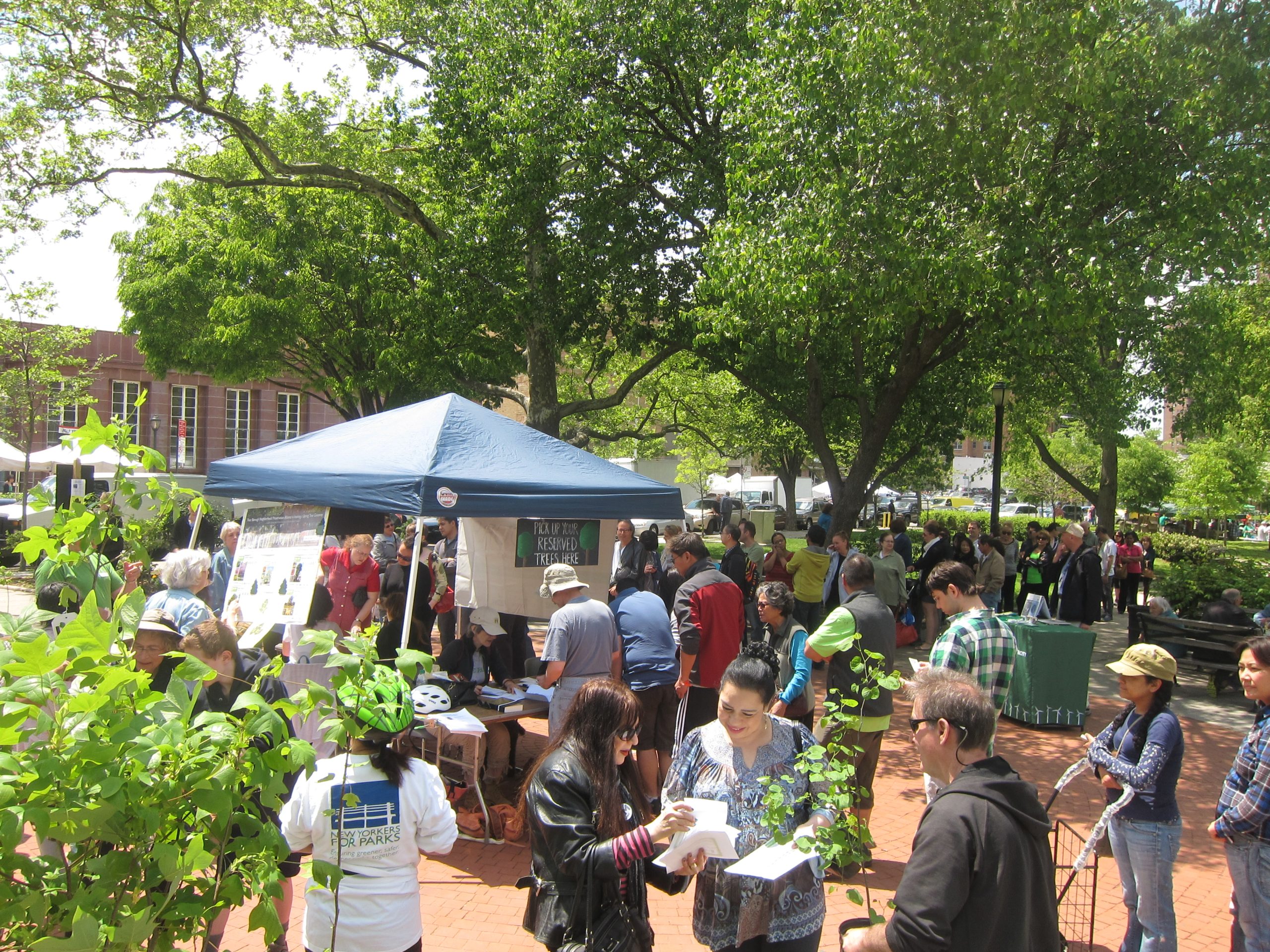
Forest Hills tree giveaway with NYRP.
Although online registration for certain events is full, it is likely that interested parties will still be able to acquire one or more trees. Trees are usually available for first-come, first-serve walk-ups during the second hour of each tree giveaway event. If advanced registration is noted online as full, NYRP recommends arriving at the beginning of an event to place your name on the waitlist.
NYRP’s tree species will offer diverse appearance alongside environmental benefits and improving property values. Event participants can acquire the following tree varieties:
Allegheny Serviceberry, American Persimmon, American Plum, Bald Cypress, Basswood, Beach Plum, Black Cherry, Chestnut Oak, Common Ninebark, Eastern Redbud, Flowering Dogwood, Hazelnut, Nannyberry, Northern Bayberry, Pawpaw, River Birch, Silky Dogwood, Silky Willow,Smooth Alder, Spicebush, Sweetbay Magnolia, Sycamore, Tulip Poplar, Washington Hawthorn, and Witchhazel
The Parks Department is also on a commendable mission. “With our contracts, in-house planting team, and Tree Time, we expect to plant between 7,000 to 9,000 trees along streets and in landscaped park areas in the spring planting season,” said Environment & Planning Communications Coordinator Julie Heffernan. Planting locations can be accessed on neighborhood tree planting maps through the Parks Department website at nyc.gov/parks/street-tree-planting
This spring, the Parks Department will not be planting trees in Forest Hills and Rego Park, but in the fall, a yet to be determined small quantity will be in store for both neighborhoods to fulfill councilmember-based allocations for the district. “These trees are expected to be planted on Metropolitan Avenue between Woodhaven Boulevard and Union Turnpike, and on Yellowstone Boulevard between Austin Street and Burns Street,” said Heffernan. Backtracking, between 2021 and 2023 in Forest Hills, 177 street trees were planted, and in spring 2024, 163 trees were planted, in addition to 91 trees last fall. In Rego Park, 44 street trees were planted between 2021 and 2023, and in spring 2024, 116 street trees were planted, along with 15 trees for last fall.
Heffernan explained the motivational factors behind the Parks Department’s planting pursuits. “Our tree planting team selects from over 130 different species, and individually assigns a tree for every planting site based on a number of criteria, including tree growing patterns, above-ground and below-ground growing space, and aesthetics. This year, we are planting a variety of Maples, Oaks, and Cherry trees throughout the city. Some unique species that you can expect to see include Spring-Chitalpa, Catalpa, Osage Orange, Heritage River Birch, Golden Rain trees, Persian Ironwood, and Eastern Redbud ‘Merlot.’”
In recent years, the most commonly planted species in Forest Hills were Sweetgum, Dawn Redwood, American Linden, Silver Linden, and Zelkova. As for Rego Park, it also held a spot for Zelkova, in addition to Snowbell, Flowering Cherry, and Gingko.
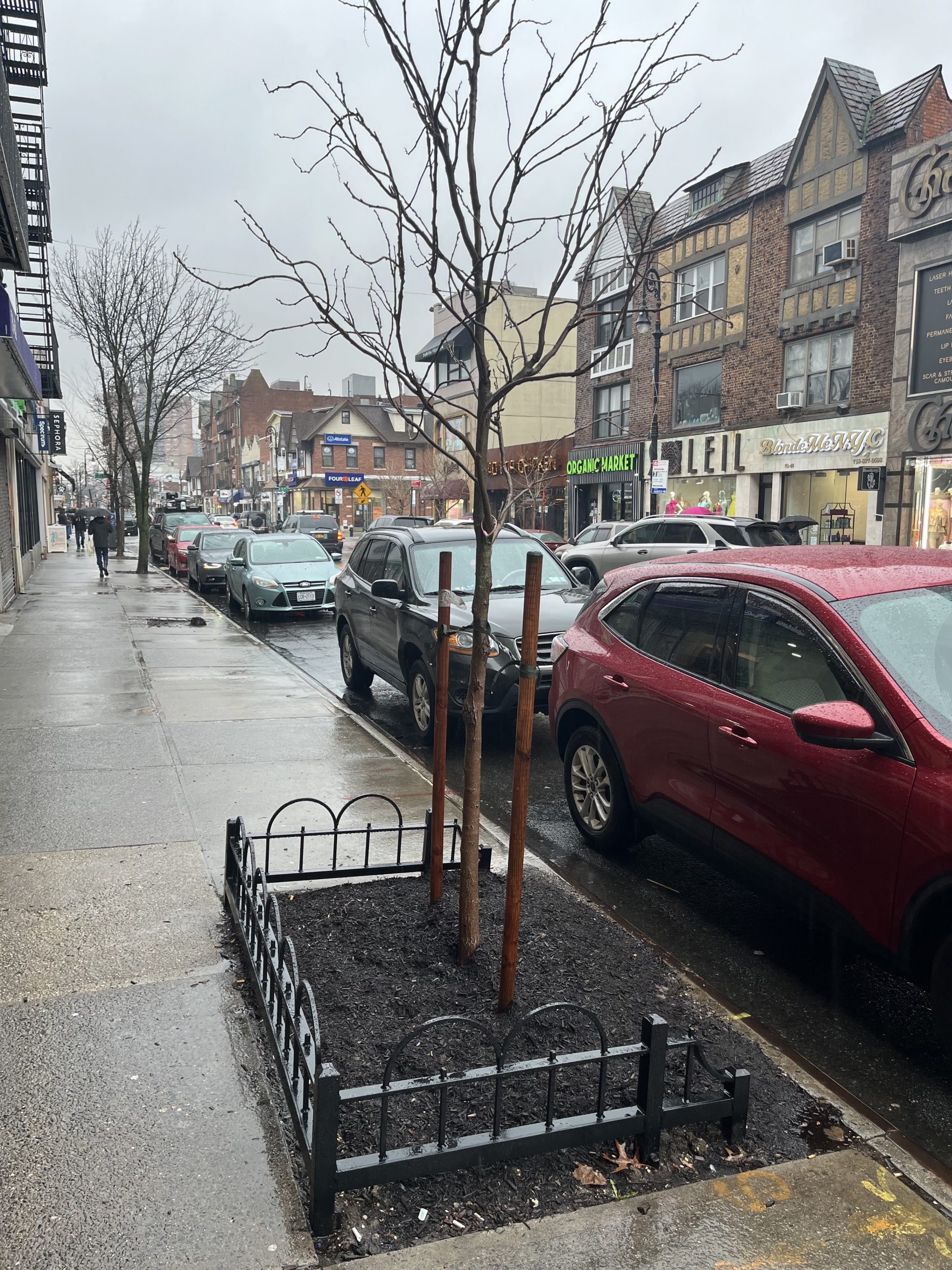
Historic buildings and trees with tree guards on Austin St.
New street trees are planted on a cyclical basis, which places the most heat-vulnerable neighborhoods in first priority. She explained, “Heat-vulnerable neighborhoods are determined and guided by the Department of Health and Mental Hygiene’s Heat Vulnerability Index (HVI).”
The benefits of planting trees at the curb and on lawns are immense. “An impressive array of environmental, social, and economic benefits improves New York City,” said Heffernan, who cited purifying and cooling the air and reducing stormwater runoff. Trees enhance public health and well-being, as well as grant a home to wildlife. “Trees shade buildings and conserve energy by reducing heating and cooling costs. Tree shade can mitigate an area’s Heat Vulnerability Index and block the sun’s harmful ultraviolet rays,” she continued.
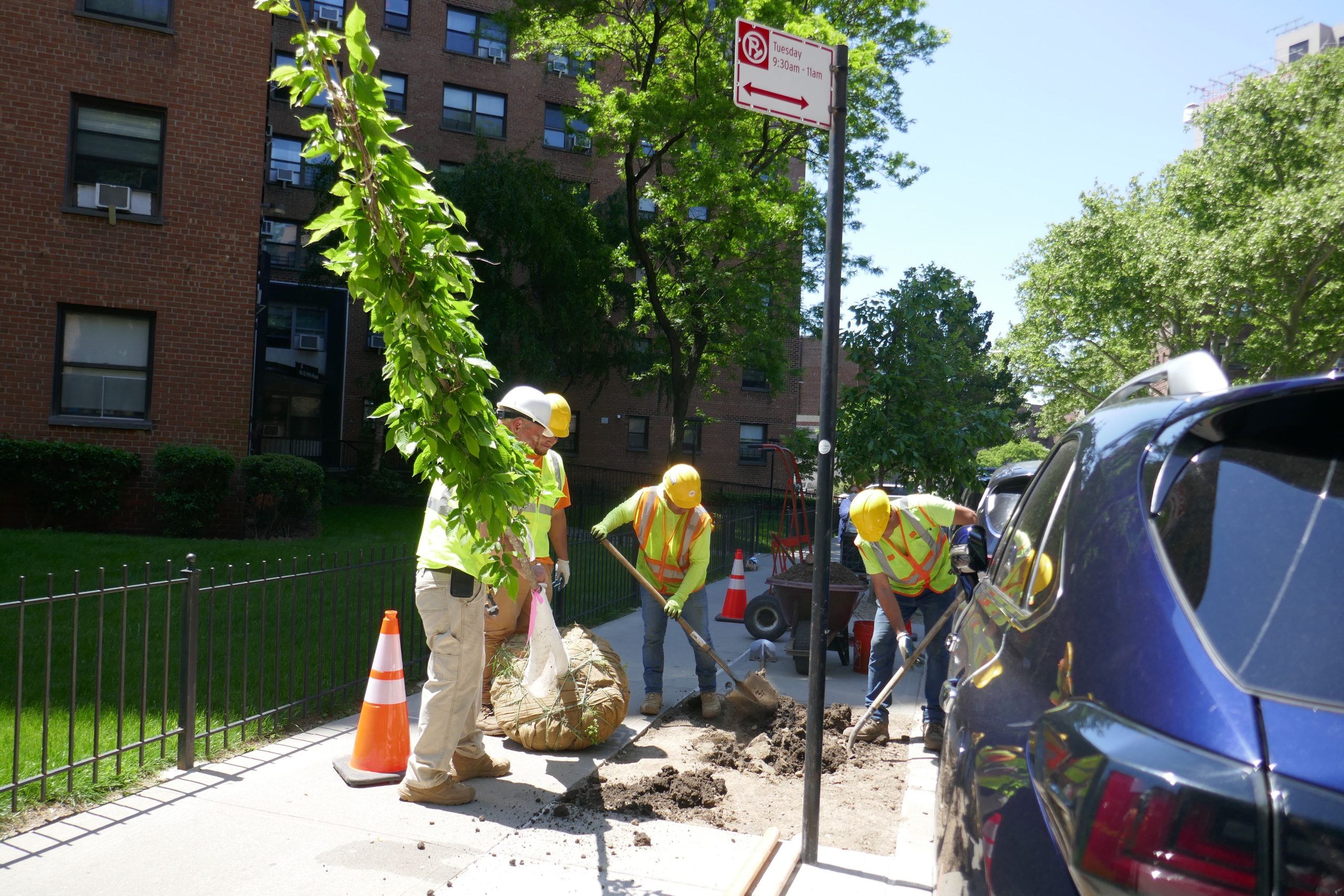
Planting American Hop-hornbeam Tree on 66th Rd.
Trees complement architecture and contribute to a picturesque setting with enhanced property values and mark a community’s history, where some monumental pillars date to the early 20th century. Personal relationships are initiated, as every tree will plant roots to stories that unfold over generations and bond community residents, and become the basis of educational opportunities, literature, and artwork. Some trees can be landmarked or feel like one. “Great neighborhoods have Great Trees,” according to the Parks Department, which has been accepting nominations for the Great Trees initiative: www.nycgovparks.org/facilities/great-trees/nominations
The Parks Department’s Stewardship Team offers dozens of street tree care events that are held citywide each year, and New Yorkers are encouraged to participate in these free educational opportunities: www.nycgovparks.org/reg/stewardship. The public can play a role in planting and pruning street trees, forest and wetland restoration, harvesting and propagating native seeds, and monitoring local wildlife.
To file maintenance requests, the public can call 311 or text 311692. In addition, the tree planting process, the installation of tree guards in a variety of styles, including custom designs, and requesting tree pit-related sidewalk repairs can be accelerated through Tree Time, a public-private partnership. Residents have the option of funding a project after visiting www.nycgovparks.org/trees/tree-care/ny-tree-trust or emailing TreeTime@parks.nyc.gov or calling 718-361-8101.
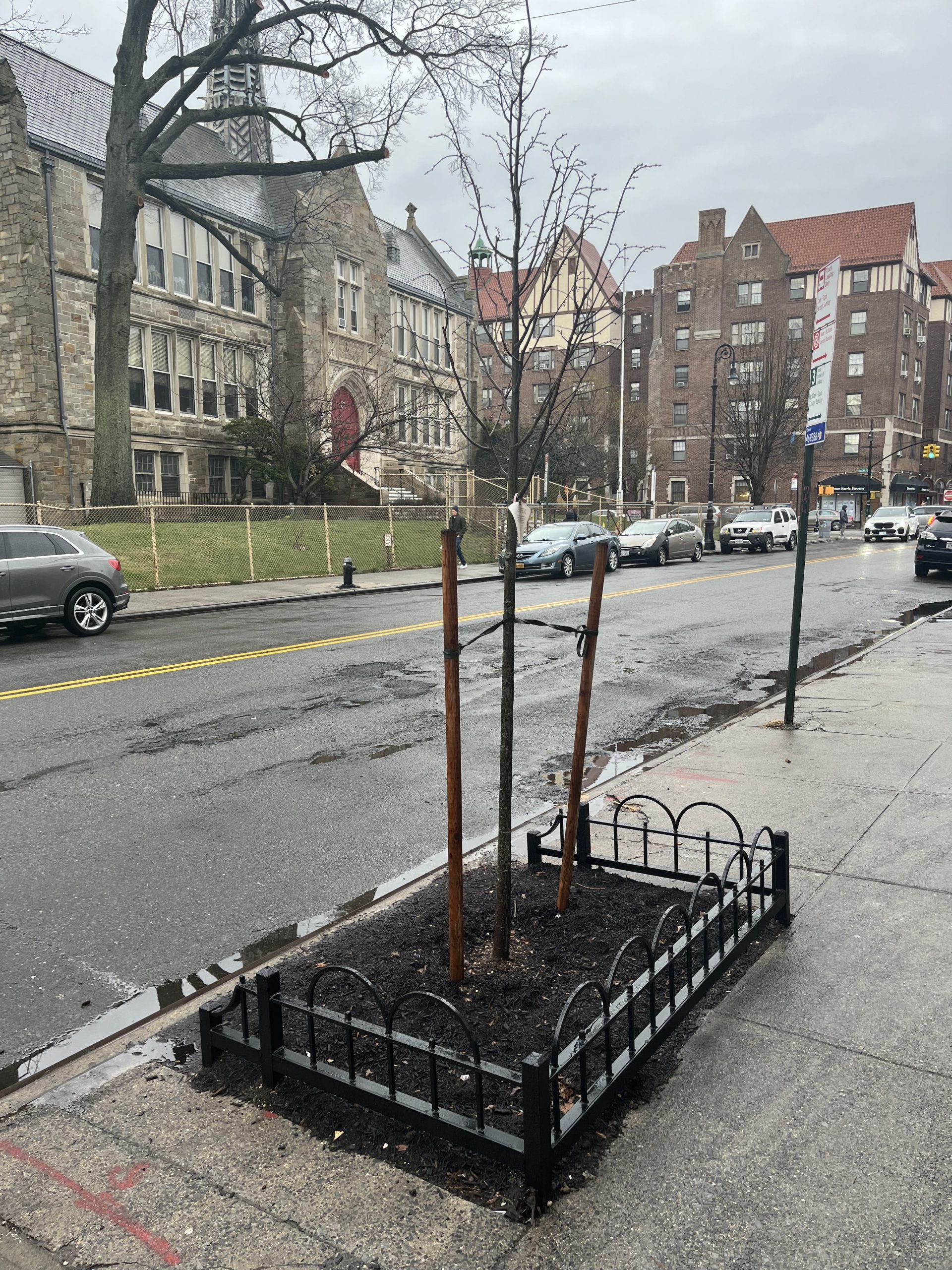
Historic buildings and trees with tree guards on Austin St.
From 2015 to 2016, the city’s third tree census was underway, where 2,241 volunteers mapped 666,134 street trees on 131,488 blocks, and the results can be analyzed: www.nycgovparks.org/trees/treescount.
On a related note, all city trees along with real-time stats, such as those that were serviced, can be found by exploring the NYC Street Tree Map: https://tree-map.nycgovparks.org. Unique facts include the top three park trees as London Plane, Pin Oak, and Honey Locust. As of today, 877,949 trees are on the map with 543 tree species, where London Plane consists of 83,788 mapped trees. A recent tree care activity as of March 23 is noted, which reads, “The Ginkgo near 110-50 Queens Boulevard was weeded and was cleared of litter.” There are 67,467 activities reported, along with 16,297 trees favorited. Ecological benefits are featured, including 1,470,022 pounds of air pollutants removed, 774,938,711 kWh energy conserved, and 1,289,292,083 gallons of stormwater intercepted each year.
As of June 3, 2023, the Parks Department announced the highest quantity of trees planted over a six-year period, with greater than 13,154 street and park trees planted citywide, and a total of 14,900 that was anticipated by the end of the month. The full speed ahead rate was attributed to appointing additional M/WBE contractors. Also pinpointed was their goal to plant trees in heat vulnerable neighborhoods, with over 5,700 planted in fiscal year 2023. For Queens, that consisted of Elmhurst, Hunters Point, Sunnyside, Long Island City, Laurelton, South Ozone Park, St. Albans, Flushing, and Woodside. As a result of an additional $136 million allocated by the mayoral administration for the program, planting trees in every sustainable spot in HVI-4 and HVI-5 neighborhoods by 2026 was announced as a Parks Department goal.
News of the season’s tree giveaway events and street tree planting pursuits are not only inspiring taking out a shovel, but advocacy through art. Visual artist Susan Varo of My Works of Art, who has a history in Queens, proudly supports planting more trees and producing artwork. She explained, “Trees are very inspirational, since they become an integral part of the focus for many of my works. In my many journeys throughout my neighborhood, I search for trees with a certain aesthetic. I am impacted by what I see, and it becomes a part of what I include in my natural landscape paintings.”
She has long admired how tree planting is significant for people, animals, and the environment. “We all need these beautiful tall plants, as they are an essential part of our ecosystem. They sustain life, provide shelter to many living species and offer a canopy to wildlife. They also preserve the soil, produce oxygen, and provide food to many animals.”
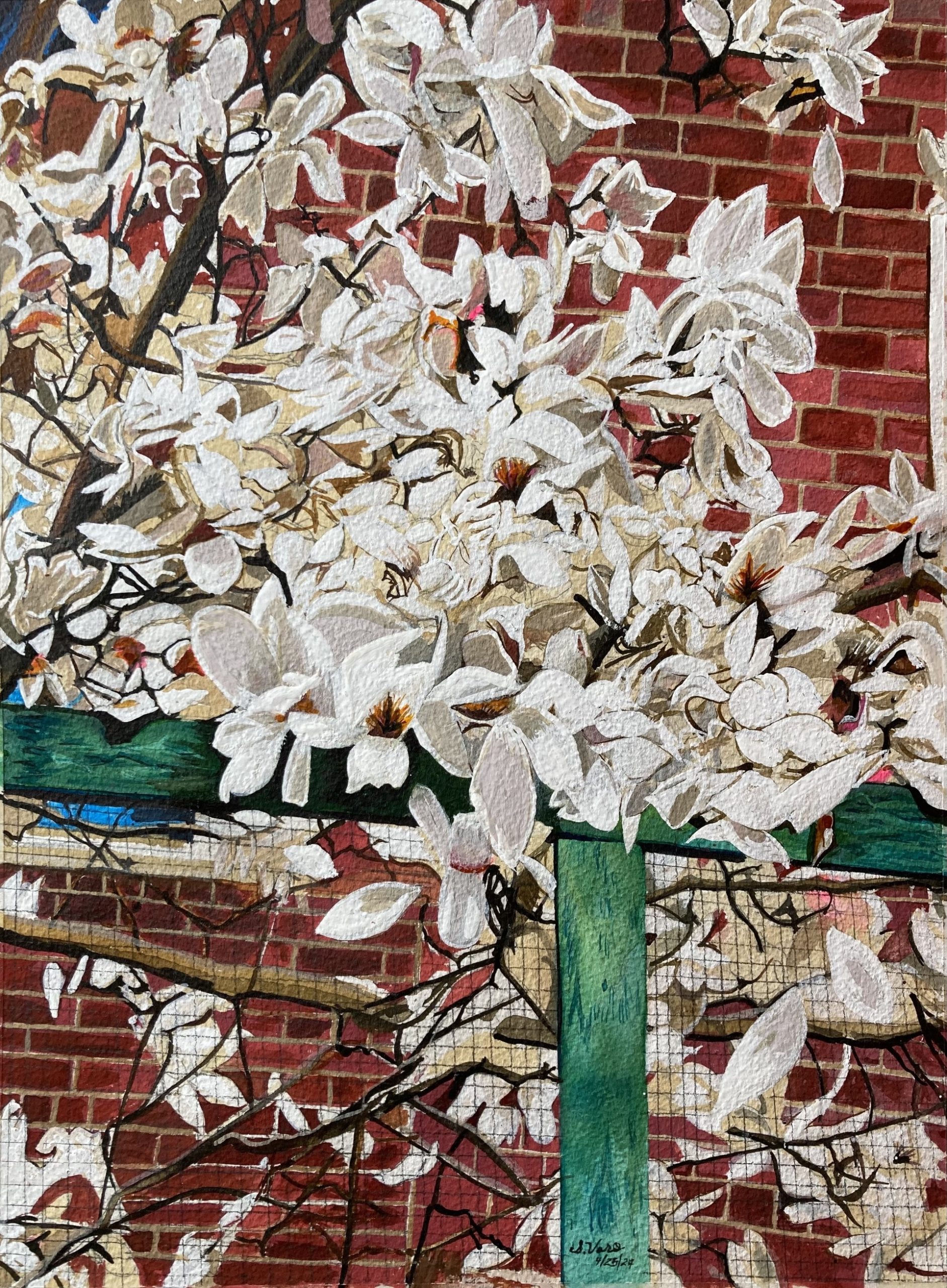
Park Briar Magnolia Tree by Susan Vara.
Varo’s painting, “Park Briar Magnolia Tree,” was inspired by her encounter with a Magnolia along the pathway of the historic apartment building at 110-45 Queens Boulevard, with its exquisitely landscaped frontage. She explained, “I was awestruck by its magnificent beauty, overflowing with stark white flowy petals. As there are many varieties of trees, the Magnolia evokes something special, along with the backdrop of a spring day. There is a certain magic when the wind blows off its petals, sending them dancing and spiraling down onto the ground. The entire area then becomes a breathtaking and picturesque-floral landscape. After studying the intricacies of this amazing plant and its petals, I immediately set out to create a watercolor painting to capture its momentary beauty.”
Varo has hopes that this season’s tree-planting initiatives will include more varieties of flowering trees, such as Magnolia, Dogwood, Crabapple, Hawthorn, Japanese Cherry, and Weeping Cherry.
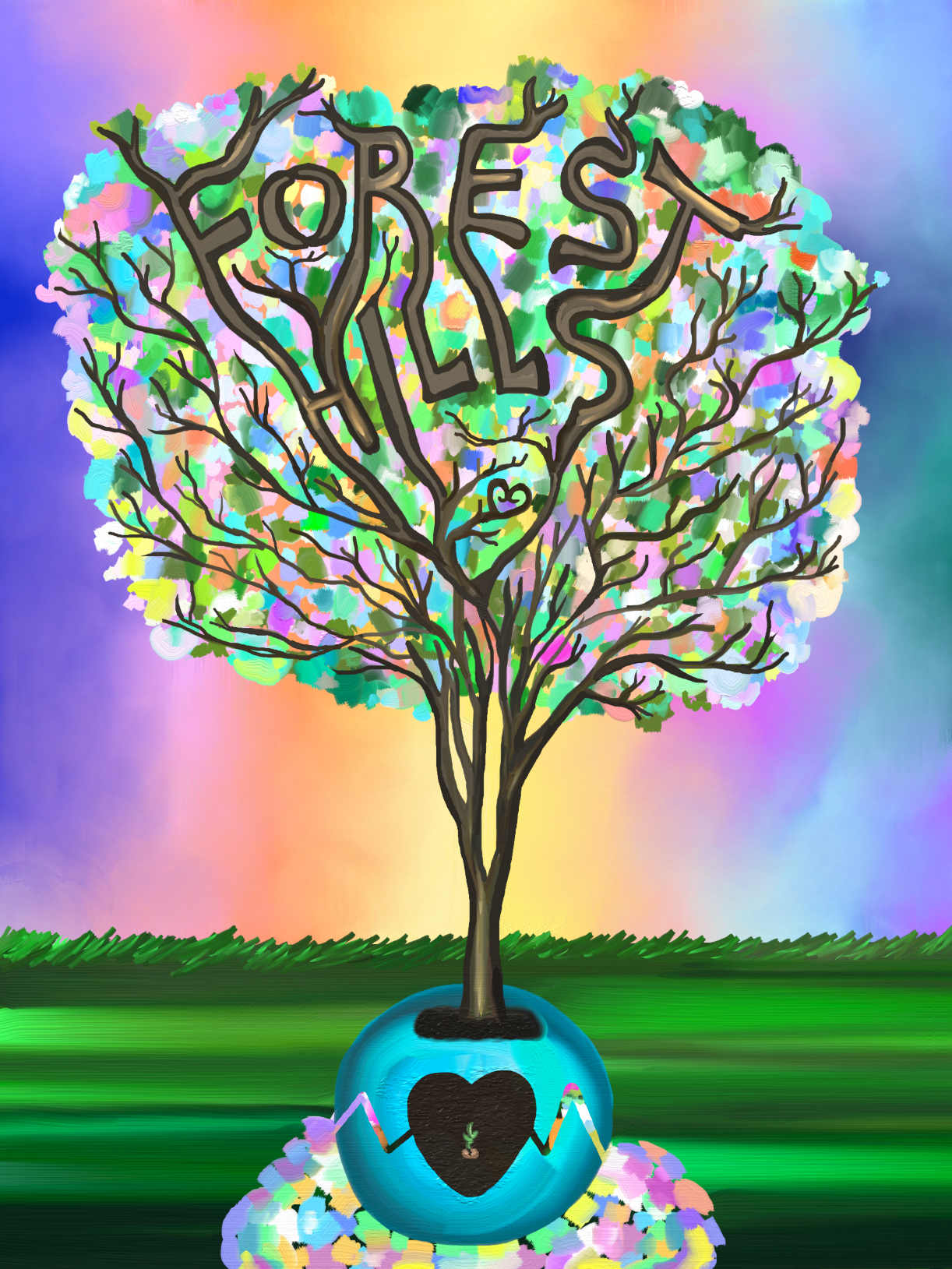
Painting by Deborah Camp.
Woodhaven resident Deborah Camp, an artist, author, and humanitarian, is an avid window and wall muralist. She has high hopes that her painting will motivate a greener community and cityscape. She explained, “My work features a tree growing out of the nutrient rich soil of our planet with limbs spelling out ‘Forest Hills,’ as a tiny sprout manages to emerge from a seed to grow within the nest of petals to greet the dawning of spring, a time of renewal. The vibrant flowers and leaves blooming from the branches symbolize our diverse community, consisting of people inspiring one another with their innovative ideas as they work, play, and learn together. The tree of Forest Hills that was once upon a time a baby sprout has grown rich in history, culture, and the arts, as it blooms this spring, ready to delight all of our senses with fragrant sweet blossoms, cooling shade, oxygen, and beauty.”
